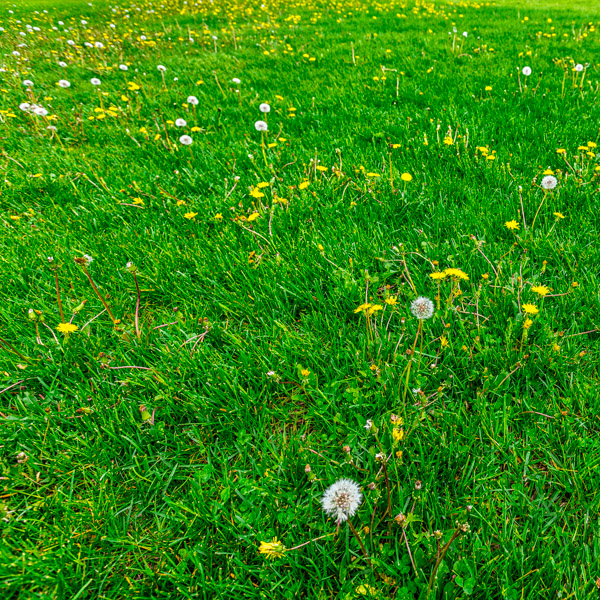
Dandelions are one tough weed with superior seeding ability, tolerance for drought and poor soil, and deep tap roots that make killing it challenging. One of the world's most prolific seeders, a single dandelion plant can make as many as 20,000 weed seeds in a year. Their fluffy, cottony seed appendages also help them spread for miles in the wind.
No wonder these broadleaf perennial weeds with bright yellow flowers and puffy seed heads are so common in lawns throughout the U.S., not to mention farm fields, roadside ditches, and untended ground everywhere. Read on to find out how to control dandelions in your yard.
How to kill dandelions
Dandelions are winter-hardy perennials with deep tap roots that go down a foot or more into the soil. They’re very proficient at sending up new shoots from root pieces left behind, so new growth will recur if you don’t kill or remove the entire root system.
Fortunately, there are several methods to remove dandelions effectively. In this article, we'll explore these options and help you choose the best solution for your yard.
Pulling dandelions
Hand-pulling is doable in small lawns or lawns with dandelions scattered here and there. Use dandelion pullers that let you loosen the area and remove the entire dandelion root to prevent regrowth.
Hand-digging works best in damp soil after a rain or in late winter or early spring when the soil is soft from winter freezing.
Plant grass seed into bare soil immediately after digging dandelions so that grass can fill in the gaps before weeds do.
Granular weed-killers
When dandelions are widespread throughout a lawn, granular weed killers kill them and other broadleaf weeds efficiently by using a lawn spreader for application. These dry broadleaf herbicide products kill most broadleaf weeds without harming grass and are most effective when applied to a damp lawn, which helps the granules stick to the blades.
Spot-spraying
When digging isn’t practical, numerous liquid herbicides or "dandelion killers" are available to spot-spray individual dandelion plants. Look for products labeled for broadleaf weed control in lawns – and ones that specifically mention dandelion control. Herbicides containing 2,4-D, MCPP, dicamba, and/or triclopyr are the most common ones that kill broadleaf weeds without harming turfgrass.
Avoid non-selective herbicides such as glyphosate and vinegar-based products when trying to kill broadleaf weeds in the lawn. Spray from these can drift onto surrounding grass and harm it along with the dandelions.
Read herbicide labels carefully before buying to know what the product kills – and what it doesn’t.

Lawn covered in dandelions.
How to prevent dandelions
Killing dandelions is only half of the battle. If you don’t address what allowed an infestation in the first place, dandelions or other weeds will quickly retake root.
Mow regularly
Mow over dandelions before they mature to prevent them from producing seeds that can spread around your yard. This won't prevent dandelion seeds from blowing in from elsewhere, but it will reduce your chances of contributing to the dandelion infestation.
Aerate the lawn
Dandelions prefer to grow in moist soils, which means that if your lawn has a lot of moisture, they will thrive. Aerating your lawn and garden can help reduce the soil's moisture and, in turn, reduce the chances of dandelions taking over.
Aeration involves using a tool that creates small holes in the soil, allowing extra oxygen to get to the soil and helping water to drain more quickly. This reduces the soil's moisture, making it a less appealing environment for dandelions to grow in.
Fertilizing
Dandelions compete with grass for nutrients and water. Regularly fertilizing your lawn will help it grow thicker and fuller, making it harder for weeds to take hold.
GreenView Broadleaf Weed Control plus Lawn Food with GreenSmart is a granular broadleaf “weed-and-feed” product that fertilizes the lawn while killing 250 kinds of weeds, including dandelions.
Seeding or Overseeding
Planting grass seed on top of existing grass or overseeding your lawn fills in bare spots and dead patches of grass, which are the most likely places for weeds to grow.
Pre-emergent herbicide
Apply a pre-emergent herbicide in the spring to prevent dandelion seeds from germinating. This kind of herbicide makes a barrier in the soil that stops seeds from growing, so they can't take root in your lawn.
GreenView Fairway Formula Spring Fertilizer Weed and Feed and Crabgrass Preventer is a three-way granular product that fertilizes, prevents crabgrass, and kills 200 broadleaf weeds, including dandelions.